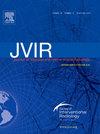Assessing Tilt and Retrieval Challenges with Inferior Vena Cava Filters: Comparison of Original and Antitilting Models of the ALN Filter
IF 2.6
3区 医学
Q2 PERIPHERAL VASCULAR DISEASE
Journal of Vascular and Interventional Radiology
Pub Date : 2025-07-14
DOI:10.1016/j.jvir.2025.07.005
引用次数: 0
Abstract
Purpose
To compare the tilt of the classical ALN (ALN Implants Chirurgicaux, Bormes-Les-Mimosas, France) inferior vena cava filter (IVCF) with that of the new optional antitilting inferior vena cava filter (OATF) in a single-center retrospective study.
Materials and Methods
This retrospective study analyzed fluoroscopic images from 539 patients who received an IVCF between April 2012 and March 2023. The primary outcome was the frontal view tilt angle of the IVCF within the inferior vena cava at insertion between the ALN classical filter (ACF) and the new OATF. Secondary outcomes included a comparison of tilt between these 2 filters at retrieval and a correlation between tilt and fluoroscopy time. Imaging and clinical data were collected from hospital databases, and statistical analysis was conducted using regression models.
Results
At placement, in the frontal view, median tilt was significantly lower in the OATF group (5° [2°–10°]) than in the ACF group (10° [6°°–15°]) (P < .01). At retrieval, the median frontal view tilt was significantly lower in the OATF group (3.5° [1°–10°]) than in the ACF group (11° [5°–16.5°]) (P < .01). Median lateral view tilt at retrieval was also significantly lower in the OATF group (3° [1°–6.5°]) than in the ACF group (8° [4°–13°]) (P < .001). At retrieval, frontal view tilt was correlated with fluoroscopy time (Spearman correlation coefficient, 0.165; n = 184) (P = .033).
Conclusions
The OATF is associated with reduced tilt compared with the classical model.

评估下腔静脉过滤器的倾斜和检索挑战:ALN过滤器原始模型和反倾斜模型的比较。
目的:在一项单中心回顾性研究中,比较经典ALN®下腔静脉滤过器(IVCF)与新型可选抗倾斜滤过器(OATF)的倾斜度。材料和方法:本回顾性研究分析了2012年4月至2023年3月期间接受IVCF的539例患者的透视图像。主要结果是在ALN经典滤波器(ACF)和新OATF之间插入时IVCF在IVC内的正面视图倾斜角。次要结果包括两种滤镜在检索时的倾斜度比较,以及倾斜度与透视时间的相关性。从医院数据库中收集影像学和临床资料,采用回归模型进行统计分析。结果:在放置时,在额平面上,OATF组的中位倾斜度(5°[2°-10°])显著低于ACF组(10°[6°-15°])。
本文章由计算机程序翻译,如有差异,请以英文原文为准。
求助全文
约1分钟内获得全文
求助全文
来源期刊
CiteScore
4.30
自引率
10.30%
发文量
942
审稿时长
90 days
期刊介绍:
JVIR, published continuously since 1990, is an international, monthly peer-reviewed interventional radiology journal. As the official journal of the Society of Interventional Radiology, JVIR is the peer-reviewed journal of choice for interventional radiologists, radiologists, cardiologists, vascular surgeons, neurosurgeons, and other clinicians who seek current and reliable information on every aspect of vascular and interventional radiology. Each issue of JVIR covers critical and cutting-edge medical minimally invasive, clinical, basic research, radiological, pathological, and socioeconomic issues of importance to the field.

 求助内容:
求助内容: 应助结果提醒方式:
应助结果提醒方式:


